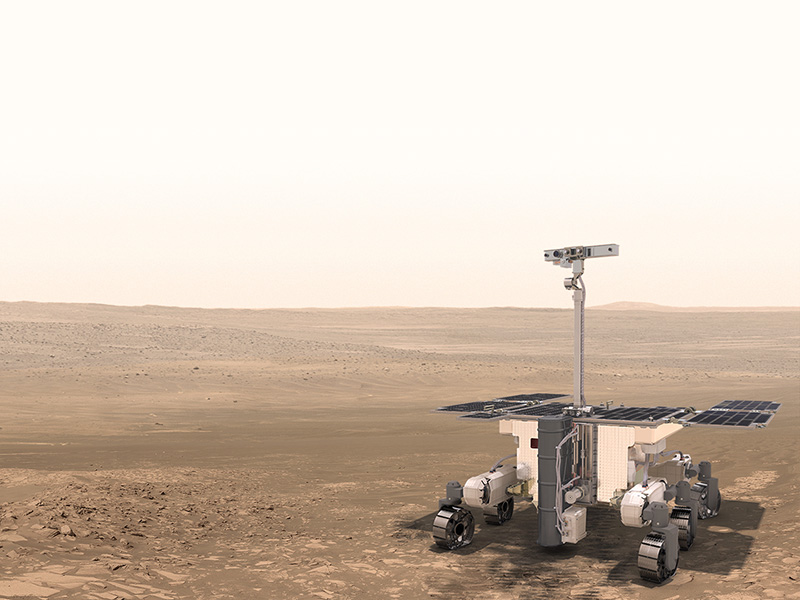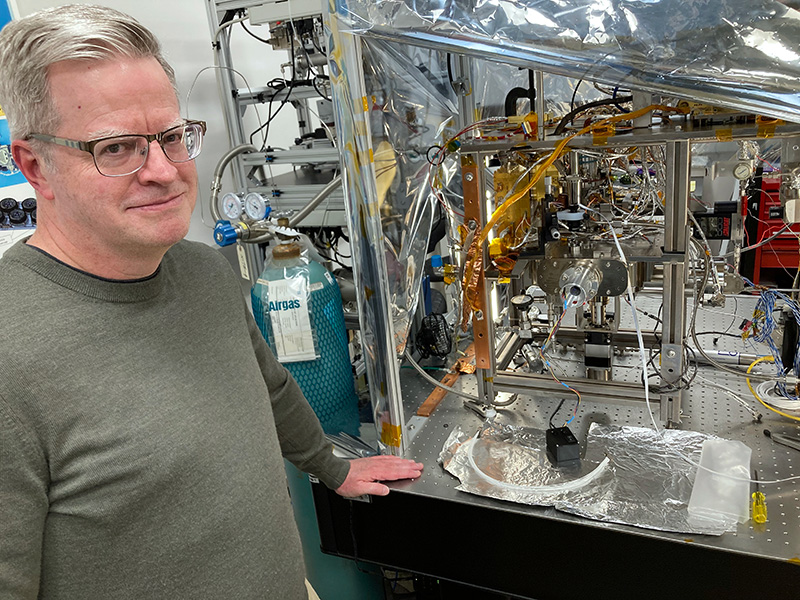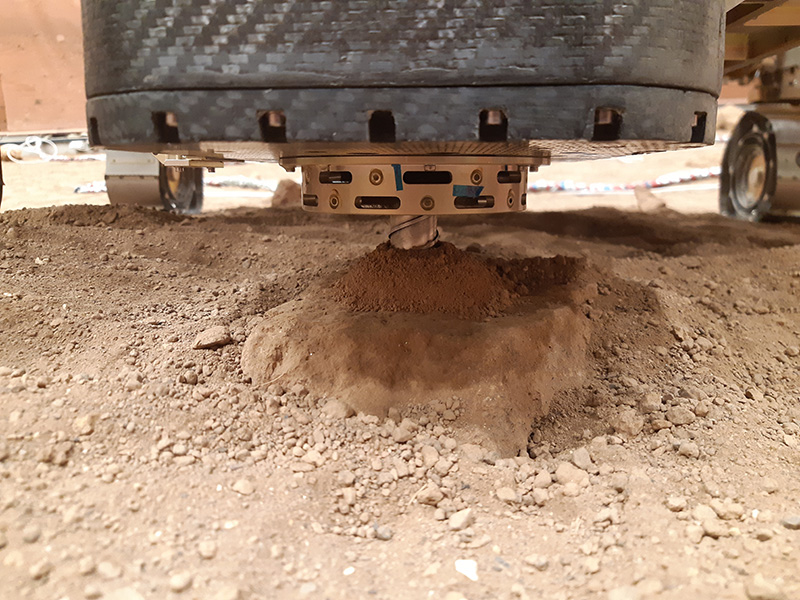The long-awaited mission that could transform our understanding of Mars
A next-generation instrument on a delayed Martian rover may be the key to answering the question of life on the Red Planet
Support sound science and smart stories
Help us make scientific knowledge accessible to all
Donate today
March 17, 2022, was a rough day for Jorge Vago. A planetary physicist, Vago heads science for part of the European Space Agency’s ExoMars program. His team was mere months from launching Europe’s first Mars rover — a goal they had been working toward for nearly two decades. But on that day, ESA suspended ties with Russia’s space agency over the invasion of Ukraine. The launch had been planned for Kazakhstan’s Baikonur Cosmodrome, which is leased to Russia.
“They told us we had to call the whole thing off,” Vago says. “We were all grieving.”
It was a painful setback for the beleaguered Rosalind Franklin rover, originally approved in 2005. Budget woes, partner switches, technical issues and the Covid-19 pandemic had all, in turn, caused previous delays. And now, a war. “I’ve spent most of my career trying to get this thing off the ground,” Vago says. Complicating things further, the mission included a Russian-made lander and instruments, which the member states of ESA would need funding to replace. They considered many options, including simply putting the unused rover in a museum. But then, in November, came a lifeline, when European research ministers pledged 360 million euros to cover mission expenses, including replacing Russian components.
When the rover finally does, hopefully, blast off in 2028, it will carry a suite of advanced instruments — but one in particular could make a huge scientific impact. Designed to analyze any carbon-containing material found underneath Mars’s surface, the rover’s next-generation mass spectrometer is the linchpin of a strategy to finally answer the most burning question about the Red Planet: Is there evidence of past or present life?
“There are a lot of different ways that you can search for life,” says analytical chemist Marshall Seaton, a NASA postdoctoral program fellow at the Jet Propulsion Laboratory and coauthor of a paper on planetary analysis in the Annual Review of Analytical Chemistry. Perhaps the most obvious and direct route is simply looking for fossilized microbes. But nonliving chemistry can create deceptively lifelike structures. Instead, the mass spectrometer will help scientists look for molecular patterns that are unlikely to be formed in the absence of living biology.
Hunting for the patterns of life, instead of structures or specific molecules, has an added benefit in an extraterrestrial environment, Seaton says. “It allows us to not only look for life as we know it, but for life as we don’t know it.”

Artist’s rendition of the Rosalind Franklin rover.
CREDIT: ESA / ATG MEDIALAB
Packing for Mars
At NASA’s Goddard Space Flight Center outside Washington, DC, planetary scientist William Brinckerhoff shows off a prototype of the rover’s mass spectrometer, known as the Mars Organic Molecule Analyzer, or MOMA. Roughly the size of a carry-on suitcase, the instrument is a labyrinth of wires and metal. “It’s really a workhorse,” Brinkerhoff says as his colleague, planetary scientist Xiang Li, adjusts screws on the prototype before demonstrating a carousel that holds samples.
This working prototype is used to analyze organic molecules in Mars-like soils on Earth. And once the real MOMA gets to Mars, approximately in 2030, Brinckerhoff and his colleagues will use the prototype — as well as a pristine copy kept in a Mars-like environment at NASA — to test tweaks to experimental protocols, troubleshoot issues that come up during the mission and facilitate interpretation of Mars data.
This latest mass spectrometer can trace its roots back nearly 50 years, to the first mission that studied Martian soil. For the twin 1976 Viking landers, engineers miniaturized room-size mass spectrometers to roughly the footprint of today’s desktop printers. The instruments were also on board the 2008 Phoenix lander, the 2012 Curiosity rover and later Mars orbiters from China, India and the US.
Anyone visiting Brinckerhoff’s prototype must first pass a display case with a dismantled copy of the Viking instrument, on loan from the Smithsonian Institution. “This is like a national treasure,” Brinckerhoff says, enthusiastically pointing out components.

At NASA’s Goddard Space Flight Center, William Brinckerhoff stands next to a working prototype of the Rosalind Franklin rover's mass spectrometer.
CREDIT: CARMEN DRAHL
Mass spectrometers are indispensable tools that are used for analytical chemistry in laboratories and other facilities worldwide. TSA agents use them to test luggage for explosives at the airport. EPA scientists use them to test drinking water for contaminants. And drugmakers use them to determine chemical structures of potential new medications.
Many kinds of mass spectrometers exist, but each “is a three-part instrument,” explains Devin Swiner, an analytical chemist at the pharmaceutical company Merck. First, the instrument vaporizes molecules into the gas phase, and also gives them an electrical charge. These charged, or ionized, gas molecules can then be manipulated with electric or magnetic fields so they’ll move through the instrument.
Second, the instrument sorts ions by a measurement that scientists can relate to molecular weight, so they can determine the number and type of atoms a molecule contains. Third, the instrument records all the “weights” in a sample along with their relative abundance.
With MOMA aboard, the Rosalind Franklin rover will land at a Martian site that roughly 4 billion years ago likely had water, a crucial ingredient for ancient life. The rover’s cameras and other instruments will help to select samples and provide context about their environment. A drill will retrieve ancient samples from as deep as two meters. Scientists hypothesize that’s far enough, Vago says, to be shielded from cosmic radiation on Mars that breaks up molecules “like a million little knives.”
Space-bound mass spectrometers must be rugged and lightweight. A mass spectrometer with MOMA’s capabilities would normally occupy multiple workbenches, but it’s been shrunk substantially. “To be able to take something that can be as big as a room to the size of like a toaster or a small suitcase and send it into space is a very huge deal,” Swiner says.

The Rosalind Franklin rover’s drill, pictured here in simulated Mars terrain, can reach up to two meters beneath Mars’s surface, deeper than attempted by any other rover on the Red Planet. It will provide samples for the rover’s mass spectrometer to investigate for signs of life.
CREDIT: ESA / THALES ALENIA SPACE
The look of life
MOMA will help scientists look for telltale signs of life on Mars by sifting through molecules in search of patterns that are unlikely to be formed any other way. For instance, lipids — compounds that include building blocks of cell membranes — have a preponderance of even numbers of carbon atoms in nearly all living things, while nonliving chemistry produces a more equal mix of even and odd numbers of carbon atoms. Finding a set of lipids with carbon atoms that are multiples of a number — rather than a random assortment — is a potential signature of life.
Similarly, amino acids — the building blocks of proteins — can be created either by life or by non-biological chemistry. They come in two forms that are mirror images of each other but are otherwise identical, like left and right hands. On Earth, life overwhelmingly contains only left-handed amino acids. Nonliving chemistry makes both left- and right-handed varieties. In other words, a large excess of either left- or right-handed amino acids is more lifelike than a more even mixture.
More generally, scientists think that chemical distributions similar to these would be indicative of life even if the molecules exhibiting the patterns don’t exist in Earth biochemistry.
Previous Mars missions that included mass spectrometers ran into problems that hampered their ability to identify signs of life. Scientists took those hard-earned lessons and designed MOMA to overcome those hurdles, including one of the most troubling ones: the notorious molecule destroyer, perchlorate. Perchlorate, which also turns up in extreme Earth environments like South America’s Atacama Desert, can degrade organic molecules at high temperatures, obscuring potential signs of life.
In 2008, the Mars Phoenix lander discovered perchlorate ions in Mars soil. Two other missions, the Viking lander and the Curiosity rover, detected chlorinated hydrocarbons — possible byproducts of perchlorate reacting with Martian molecules in the high-temperature ovens of their mass spectrometers. This meant that perchlorate may have obscured any evidence of organic molecules that could indicate life.
MOMA cleverly circumvents the perchlorate problem with an ultraviolet laser. The laser vaporizes and ionizes samples in one go, with pulses of light lasting under two nanoseconds — too quick for perchlorate reactions to occur.
An ultraviolet laser vaporizes organic compounds in a sample of pulverized Martian surface, while also giving compounds an electrical charge. Both processes are essential for the compounds to be analyzed with mass spectrometry.
CREDIT: NASA’S GODDARD SPACE FLIGHT CENTER CONCEPTUAL IMAGE LAB
The laser has another benefit: It leaves molecules largely intact when giving them a charge to create ions. Viking and Curiosity generated ions by bombarding them with electrons. Those collisions didn’t preserve weak chemical bonds that can be important for determining the structures of molecules in a sample, whereas the laser keeps molecule fragmentation to a minimum. MOMA can then sort those relatively intact ions and deliberately fragment a single ion of interest in isolation, something neither Viking nor Curiosity could do. By analyzing the resulting puzzle pieces of that ion, it’s possible to determine the chemical structure of the original molecule from the Martian sample and thus identify what it is.
It will be the first time this laser technique goes to Mars, but tests on Earth suggest it will work. The prototype found traces of organic molecules even in the presence of more perchlorate than Phoenix detected in Martian soil, Brinckerhoff says. And in Mars-like samples collected in Yellowstone National Park, it detected lipids and other molecules that are more complex than ones picked up on previous Mars missions.
MOMA, like its predecessors, also has high-temperature ovens and scientists can still opt to use these instead of the laser to vaporize samples. If the laser turns up hints of amino acids, for instance, the oven option could provide information the laser cannot. When in oven mode, MOMA uses three chemical reagents that stabilize molecules to facilitate mass spectrometry. One of these, which has never before been used on Mars, is there to tell apart left- and right-handed amino acids, enabling it to make a case for living or nonliving origins in a way that prior missions could not.
MOMA won’t be the last word on whether life ever existed on Mars. Even the most tantalizing results would have to be confirmed by repeated experiments and lines of evidence from the rover’s other instruments, Vago says. Some confirmatory work also could take place through other missions or even someday from analysis of Mars samples brought back to Earth. “We will need to build a case, because otherwise nobody’s going to believe us,” Vago says.
The international team of scientists that has been working on the mission knows what they need to build that case, but until the Rosalind Franklin Rover lands on the Red Planet’s surface, they can’t get started. All of those scientists shared the disappointment in March 2022 of seeing the long-stalled mission delayed once again.
But for Brinckerhoff, that disappointment is tempered with excitement: After all, the mission is still alive. “This thing is the best of all of us,” he says, “and just to see it operate on Mars is going to be career catharsis.”
10.1146/knowable-050323-1
TAKE A DEEPER DIVE | Explore Related Scholarly Articles




